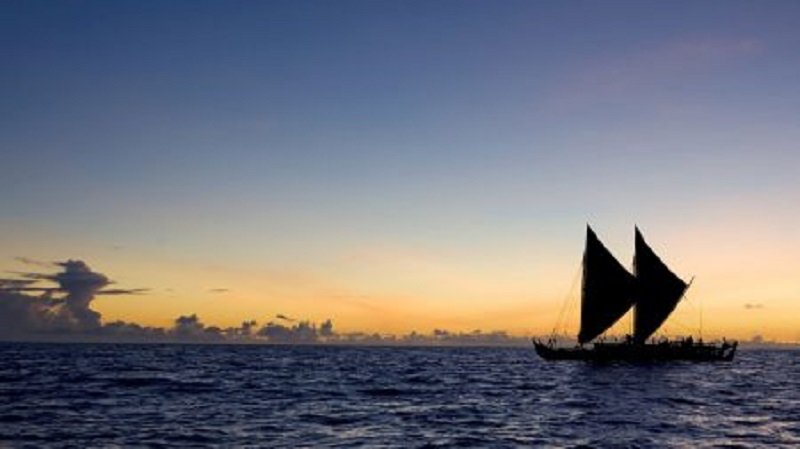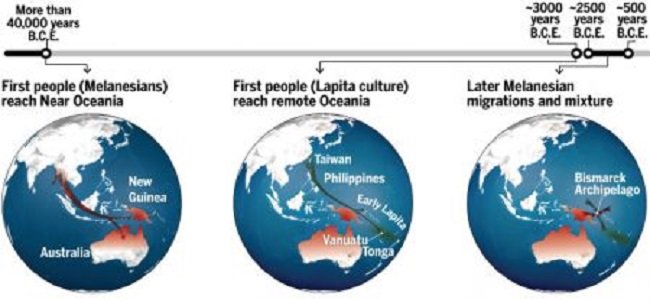
Now, the first genome-wide study of ancient DNA from prehistoric Polynesians has boosted the first idea: that these ancient mariners were East Asians who swept out into the Pacific. It wasn't until much later that Melanesians, probably men, ventured out into Oceania and mixed with the Polynesians.
"The paper is a game-changer," says Cristian Capelli, a population geneticist at the University of Oxford in the United Kingdom, noting that that it settles a decades-long dispute. By showing that the East Asians hopscotched past islands already populated by Melanesians without picking up their genes, it is also a case study in how culture can initially bar mixing between groups. "Farmers move in and don't mix much with the hunter-gatherers," says evolutionary geneticist Mark Thomas of University College London. "We see this again and again and again" elsewhere in the world.
The first Polynesians left plenty of tantalizing artifacts, including distinctive stamped red pottery, obsidian tools, and shell ornaments. Collectively known as the Lapita culture, this set of artifacts first appeared more than 3000 years ago in the Bismarck Archipelago in New Oceania (see map below). This culture grew taro, yams, and breadfruit; brought pigs and chickens; and spread rapidly to the islands of Vanuatu and New Caledonia and eventually to Fiji, Tonga, Samoa, and beyond.
Early farmers rode 'express train' to remote Pacific Islands
The first Polynesians sailed across Oceania at least 3000 years ago without mingling with the Melanesians already living there.
Back in 1985, archaeologist Peter Bellwood of the Australian National University in Canberra proposed that the Lapita had roots in farming cultures in East Asia. Based on dating of Lapita sites, he proposed that they moved rapidly from mainland China to Taiwan and the Philippines, then out across the open ocean from Vanuatu to Samoa, covering 24,300 kilometers in about 300 years. This "express train" picture fit with linguists' models, in which Austronesian languages spread from East Asia into Oceania and were distinct from Papuan languages in Melanesia.
But other researchers argued that the DNA of living Polynesians showed evidence that their Lapita ancestors had lingered in Melanesia, mixing with the locals and slowly spreading eastward. This so-called "slow boat" model had prevailed in recent years.
In the new study, an international team extracted ancient DNA from the skeletons of four ancient women from the islands of Vanuatu and Tonga, dated to 2300 to 3100 years ago, including three directly associated with the Lapita culture. The team sequenced the DNA at up to 231,000 positions across the genomes of each skeleton and compared the sequences to those of nearly 800 present-day people from 83 populations in East Asia and Oceania.
The four women were from a distinct population that had no evidence of mixing with the ancestors of people living in Papua New Guinea today, as the team reports in Nature this week. Instead, the women shared all their ancestry with the indigenous Atayal people in Taiwan and the Kankanaey people in the Philippines. "The Lapita have no evidence for Papuan ancestry," says co-author Pontus Skoglund, a postdoc in David Reich's lab at Harvard Medical School in Boston. That suggests that their ancestors rode the fast train, sweeping all the way to Oceania without mixing with Melanesians on the way.All the evidence from different disciplines has come together ... the genomics has clinched it.
Peter Bellwood, archaeologist, Australian National University in Canberra
Polynesians today do carry a significant amount of Melanesian DNA. But that DNA is in relatively long, unbroken chunks, the analyses found, suggesting that it was incorporated into Polynesians' genomes recently, perhaps about 500 to 2500 years ago, after the Lapita period. The team also noted that the Polynesian X chromosome has less Melanesian DNA than the other nuclear chromosomes. Because X chromosomes are more likely to be inherited from mothers (sons get only a Y from their fathers), that suggests that much of the Melanesian DNA came through the male line, as Melanesian men interbred with Polynesian women. "The female ancestors of modern-day Oceanians are mainly Lapita, whereas their male ancestors include Papuans," Skoglund says.
Bellwood is pleased. "All the evidence from different disciplines has come together," he says. By getting DNA from the ancient Polynesians themselves, "the genomics has clinched it."




Reader Comments
to our Newsletter